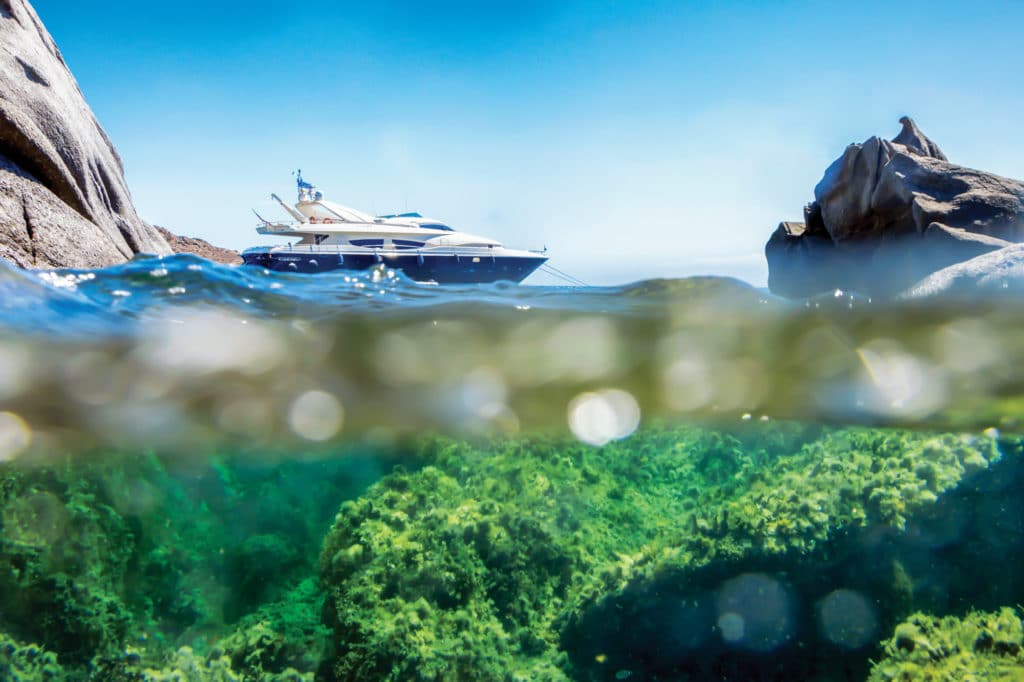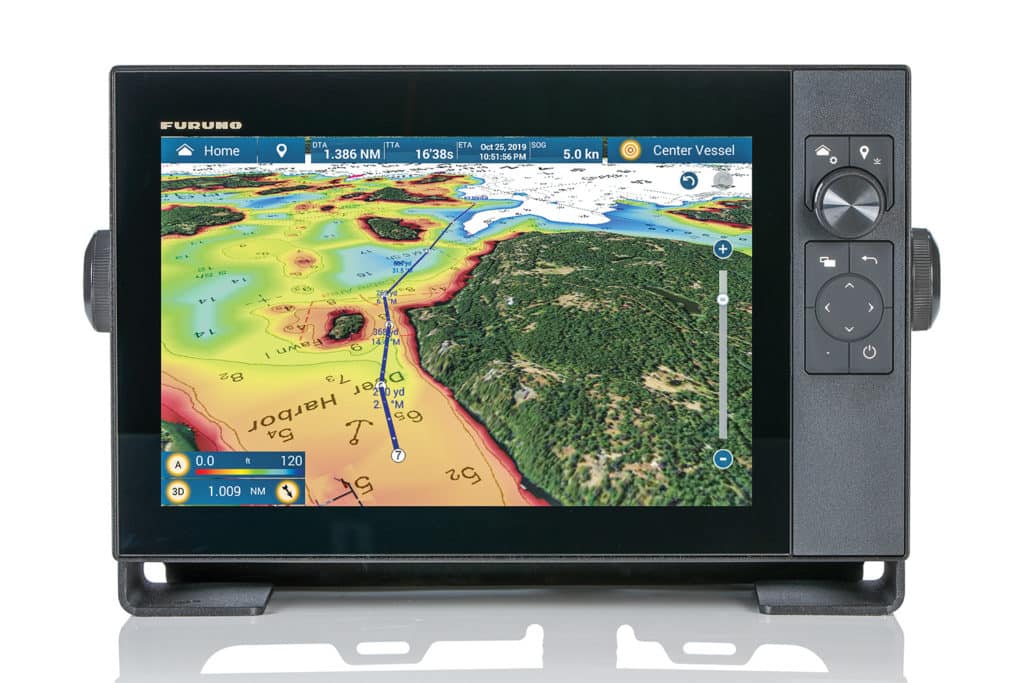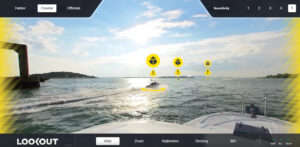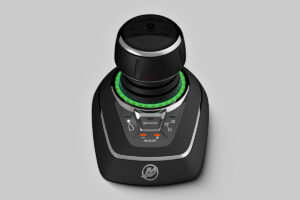
In 2003, I participated in the Marion to Bermuda Cruising Yacht Race, a 645-nautical-mile marathon stretching from Massachusetts to the Onion Patch. I remember coming on deck one day and seeing our depth sounder acting funny. Instead of generating metrics, it simply read “off soundings.” Being a self-professed Curious George, I spent some off-watch hours studying paper charts, trying to conceptualize how much saline was below our keel. While these metrics were irrelevant—we were racing sailboats, not trolling canyons—I remember wishing that our depth sounder could dig deeper than 600 feet.
Turns out, plenty of anglers also want extra performance from the fish finders that come bundled in contemporary multifunction displays. And for owners of Furuno TZtouch3 multifunction displays, that enhancement is now here.
Furuno unveiled its TZtouch3 MFDs at the 2020 Miami International Boat Show. In addition to new quad-core architecture, and other hardware and software upgrades, TZtouch3 MFDs have dual-channel 1-kilowatt chirp fish finders, as well as traditional continuous-wave 50- and 200-kilohertz fish finders that were standard with the company’s TZtouch2 MFDs.
While the new features represented a significant payload upgrade, Furuno realized that big-game anglers wanted the ability to put even more power into the water. The result is the Deep Impact DI-FFAMP power amplifier, which boosts the TZtouch3′s fish-finding capabilities by up to 300 percent, giving users the ability to probe depths surpassing 10,000 feet.
Furuno’s DI-FFAMP ($2,195) is a black-box power amplifier designed to be table- or bulkhead-mounted. Deep Impact amplifiers have seven ports: a ground-wire connector, a power port, two MFD connections, two transducer ports (a high-frequency and low-frequency connection for each continuous-wave transducer; a chirp transducer can be connected to the low-frequency port), and a keying pulse connection allowing the sounder modules to transmit simultaneously.
Once connected to a TZtouch3, the DI-FFAMP acts much like a power amplifier for a stereo, dramatically increasing the amount of acoustic power a networked transducer can transmit. Eric Kunz, Furuno’s senior product manager, says each TZtouch3 has two fish-finder channels that feed into the amplifier.
“The TZtouch3 has two independent and agile channels that let you select what frequencies you want to use—it gives you a lot of combinations,” Kunz says, adding that any target deeper than 150 to 200 feet will look better on a TZtouch3 display if the system has a Deep Impact amplifier. “More power on the target will give you better detail.”

Recent years have seen a shift toward wider-beam transducers projecting acoustic energy across a wide swath of water column or ocean floor, delivering greater macro-level awareness of what’s below the keel. “The problem is that these transducers take the fish finder’s transmitted energy and spread it out with their wide beams,” Kunz says. “Users get weaker returns because the energy is spread out. The DI-FFAMP makes up for the wide beam by putting more power into the water.”
Additionally, certain fish species don’t have air bladders and, as a result, tend to look a lot like the water column itself when viewed with a standard fish finder. “You need a higher-powered fish finder to see them,” Kunz says.
This same power also helps anglers serious about deep-drop fishing, with swordfish and snowy grouper examples of species that are easier to target and identify with a TZtouch3 that’s amplified by a DI-FFAMP.
As noted, a TZtouch3 MFD can either transmit over fixed, continuous-wave frequencies (50/200 kHz), or it can chirp its transmissions (sending a sweep of frequencies over a longer time period than a fixed-frequency transducer, and thus putting more power into the water and yielding higher-resolution sonar imagery).
At a certain depth, somewhere around 2,000 feet below the transducer, a TZtouch3 will switch from chirping to a continuous-wave signal, Kunz says. “If you want to chirp in deep water, a DI-FFAMP will allow you to do that,” he adds.
Cooler still, Deep Impact amplifiers also are designed to be controlled and leveraged by any onboard and networked TZtouch3 or TZtouch2 that’s running version 7 (or higher) software. This means an owner can upgrade to a TZtouch3 and DI-FFAMP at the helm, and view and control the Deep Impact’s bolstered imagery from a flybridge- or cockpit-installed TZtouch3 or TZtouch2 display.
“This gives an owner certain advantages over a networked sounder,” Kunz says. “It’s a different way to skin a fish.”
Alternatively, owners can add a Furuno DFF3D multibeam sonar to a TZtouch3 and Deep Impact installation. “This lets [an owner] leverage both products as a package,” he says. “A DFF3D and TZtouch3 MFD, plus a Deep Impact amplifier is really the ticket for serious anglers.”
With a system that includes a TZtouch3 MFD, a Deep Impact amplifier and a DFF3D, owners can spec a single combination transducer that can simultaneously handle all transmissions and returns. “There’s no frequency crossover,” Kunz says. “So they all work without interference, and the transducer [can be installed on] the best location on the boat.”
Returning to the stereo analogy, it’s possible to blow out speakers by combining a powerful amplifier with overly liberal use of the volume knob, and the same holds true for transducers. To prevent this mishap, Airmar- and Furuno-branded transducers have a feature called Xducer ID that embeds a microcontroller in each transducer. This microcontroller contains factory specifications for the transducer, and it performs an electronic handshake with the MFD’s fish finder (or networked sounder) that prevents the system from smoking its transducer.
So, if you enjoy deep-dropping for dinner, or just want to understand what’s below your keel, Furuno’s DI-FFAMP could be a great addition to a TZtouch3-equipped yacht. And while city ordinances sometimes limit the decibels that a car or home stereo can pump out, anglers are free to crank the power on their fish finders.









